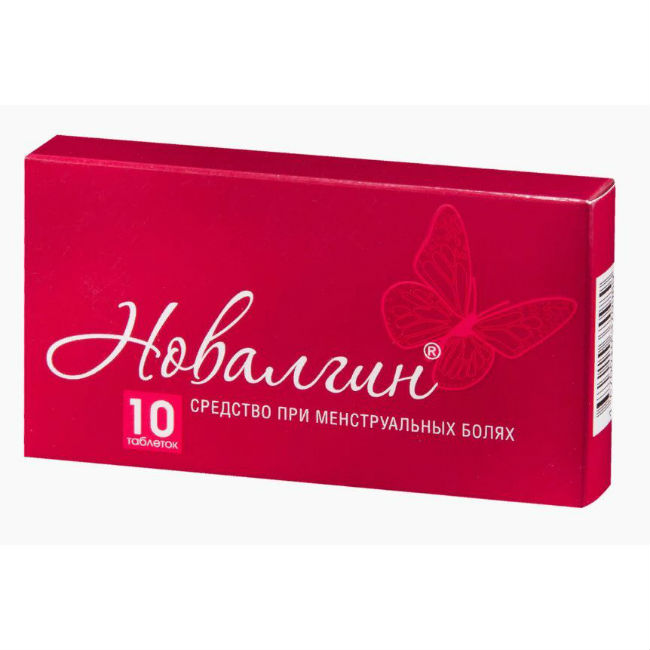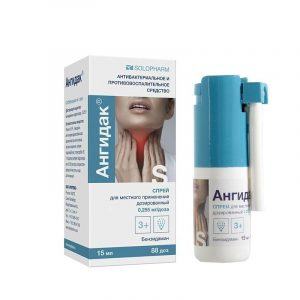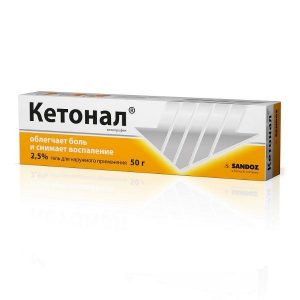Description
Latin name
NOVALGIN
release form
tablets
Pharmacological action
Combined drug whose action is determined by the components that make up it. Paracetamol and propiphenazone have an analgesic and antipyretic effect. Caffeine has a psychostimulating (stimulates the psychomotor centers of the brain), analeptic effect, eliminates drowsiness and a feeling of fatigue, increases physical and mental performance. The action begins 15-30 minutes after administration.
Indications
– Treatment of mild to moderate pain syndrome with primary dysmenorrhea (painful menstruation in the absence of organic changes from the genitals)
– mild to moderate pain syndrome of various origins: headache, migraine, toothache, arthralgia, myalgia
– febrile syndrome (as an antipyretic agent).
Contraindications
– Severe hepatic and / or renal failure
– deficiency of glucose-6-phosphate dehydrogenase
– inhibition of bone marrow hematopoiesis (leukopenia, anemia, including hemolytic acute leukemia srd recurrent polyposis of the nose and paranasal sinuses and intolerance to acetylsalicylic acid, or other non-steroidal anti-inflammatory drugs (including a history)
– conditions accompanied by respiratory depression
– intracranial hypertension
– acute myocardial hypertension
– glaucoma
– pregnancy, lactation
– children under 12 years old
– lactase deficiency
– lactose intolerance
– glucose-galactose malabsorb Oia
– hypersensitivity to the components of the drug.
Precautions: peptic ulcer of the stomach and duodenum (in the stage of exacerbation), advanced age, moderate dysfunction of the liver or kidneys, bronchial asthma.
Special instructions
Excessive consumption of caffeinated products during treatment may cause symptoms of caffeine overdose.
At the time of treatment, you must stop drinking alcohol.
Influence on the ability to drive vehicles and control mechanisms
Caution should be exercised when taking the drug when driving vehicles and engaging in other activities, requiring increased concentration of attention and speed of psychomotor reactions.
For impaired renal function
Caution for moderate impaired renal function
For impaired liver function
Caution for moderate impaired liver function.
Use in old age
Precautions in old age.
Use in childhood
Contraindicated in children under 12 years of age.
Composition
1 tab.:
– paracetamol 200 mg
– propiphenazone 200 mg
– caffeine 50 mg
Dosage and administration
Inside, after meals, with a small amount of liquid. Adults take 1-2 tablets 1-4 times a day. The daily dose should not exceed 6 tablets. Children from 12 to 18 years old on a tablet up to three times a day.
Duration of admission is not more than 3 days as an antipyretic and not more than 5 days as an anesthetic.
Side effects
Dizziness, sleep disturbance, palpitations, dyspnea, vomiting, heaviness and unpleasant sensations in the stomach, leukopenia, agranulocytosis, hemolytic anemia, and hemolytic hemoglycemia, allergic hemogiemogememia and hemoglycemia.
In case of adverse reactions, be sure to consult your doctor about further administration of the drug.
Drug Interactions
Paracetamol reduces the effectiveness of uricosuric agents.
The simultaneous use of paracetamol in high doses increases the effect of anticoagulants (decreased synthesis of procoagulant factors in the liver).
Inducers of microsomal liver enzymes, ethanol and hepatotoxic drugs increase the production of hydroxylated metabolites of paracetamol, which makes it possible to develop severe intoxications even with a small overdose.
Prolonged use of barbiturates reduces the effectiveness of paracetamol.
When used simultaneously with ethanol, the risk of developing acute pancreatitis is increased.
Myelotoxic drugs increase the hematotoxicity of paracetamol.
Caffeine is an adenosine antagonist (large doses of adenosine may be required). With the simultaneous use of caffeine and inducers of microsomal liver enzymes, it is possible to increase metabolism and increase caffeine clearance of inhibitors of microsomal liver enzymes – a decrease in caffeine metabolism in the liver.
Mexiletine reduces caffeine excretion to 50% nicotine increases caffeine excretion rate.
Monoamine oxidase inhibitors, furazolidone, procarbazine and selegiline – large doses of caffeine can cause the development of dangerous cardiac arrhythmias or severe. increase blood pressure.
Caffeine reduces the absorption of calcium preparations from the gastrointestinal tract reduces the effect of narcotic and hypnotics drugs increases the excretion of lithium preparations in the urine accelerates absorption and enhances the action of cardiac glycosides, increases their toxicity.
The simultaneous use of caffeine with -adrenergic blockers can lead to mutual suppression of therapeutic effects with -adrenomimetics – to additional stimulation of the central nervous system and other additive: toxic effects.
Caffeine can decrease clearance of theophylline and, possibly, other xanthines, increasing the possibility of additive pharmacodynamic and toxic effects.
Propiphenazone can enhance the effect of oral: hypoglycemic agents, sulfa drugs, anticoagulants, the ulcerogenic effect of glucocorticosteroids, and reduces the effectiveness of potassium-sparing diuretics.
Absorption of the components of the drug may decrease with simultaneous use with colestyramine, m-anticholinergics, antidepressants.
Overdose
For paracetamol
Symptoms: pale skin, nausea, within the first 24 hours after ingestion, vomiting, anorexia, abdominal pain impaired glucose metabolism, metabolic acidosis. Symptoms of impaired liver function may occur 12-48 hours after overdose. In severe overdose – liver failure with progressive encephalopathy, coma, lethal outcome (10 g when converted to paracetamol or 50 tablets of the drug) acute renal failure with tubular necrosis (including in the absence of severe liver damage).
Treatment: administration of SH-group donors and precursors of glutathione-methionine synthesis within 8-9 h after overdose and acetylcysteine – within 8 h. Need for additional therapeutic measures (further methionine administration, intravenous acetylcysteine-dependent administration) paracetamol in the blood, as well as the time elapsed after his reception.
For caffeine
Symptoms: gastralgia, agitation, anxiety, movement anxiety, confusion, delirium, dehydration, tachycardia, arrhythmia, hyperthermia, increased urination, headache, increased tactile or painful sensitivity, sensitization, pain blood ringing in the ears,
convulsions (with acute overdose – tonic-clonile).
Caffeine in doses of more than 300 mg / day (including on the background of abuse of coffee – more than 4 cups of natural coffee 150 ml) can cause anxiety, tremor, headache, confusion, extrasystole.
Treatment: gastric lavage if caffeine was taken in the last 4 h at a dose of more than 15 mg / kg and there was no vomiting caused by caffeine intake of activated carbon, laxatives for hemorrhagic gastritis – administration of antacids, gastric lavage with an ice-cold 0.9% sodium chloride solution maintaining lung ventilation and oxygenation in convulsions – intravenous diazepam, phenobarbital or phenytoin maintaining fluid and saline balance.
Storage Conditions
In a dark place at a temperature not exceeding 25 ° C. Keep out of reach of children.
Shelf life
3 years.
Active ingredient
Caffeine, Paracetamol, Propifenazone
Terms and conditions
without prescription
Dosage form
tablets
Prescription
Prescription
For adults, Children over 12 a



